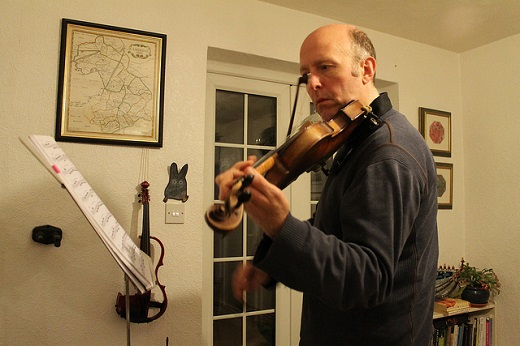If practicing violin is so important, why don’t they teach us how?
Walk into any orchestra, band, music school, or anywhere musicians hang out and say, “Practicing is important!”, and you will get absolutely no disagreement.
We all know practice is important to improving our skills. But we’re not born knowing how to practice, so why, for the love of music, aren’t teachers teaching students HOW to practice?
Do you practice violin like this?
A typical ineffective practice session looks like this for many students: Start at the very beginning of a piece, play until they mess something up, back up and play it again. They proceed through the piece, messing up and trying again. Sometimes, students have to go to the very beginning of a piece if they mess up, because they are unable to start in the middle.
Sadly, when they get to the end of the piece, they have made no permanent gains or progress. They generally cannot explain WHY they mess up in certain spots, and don’t even remember where the problem spots are!
I can blame teachers all day long, but really, we have to take responsibility for our own practice sessions! That is our sacred solitary time when WE are in charge! Let’s make sure you are armed with these important tips and tricks to help you make your violin or fiddle practice sessions mind-blowingly effective and efficient!
Powerful tips for effective violin practice
- Have a plan: a practice diary or a daily or weekly practice plan template is a very useful tool.
- Budget your time: part of your practice plan should include a list of everything you need to work on and the amount of time you can spend on each item.
- Know which practice techniques to use at which times: I have picked up many tools along the course of my violin journey. Some are my own inventions, others were passed on to me by my teachers. It is powerful to have lots of tools in your toolbox, and even more powerful to know which tool is the best for which goal or problem. (Some examples: practicing with metronome, practicing string crossings with open strings only, clap rhythms, isolating problem spots). I discuss these in depth in my Suzuki Book 3 online violin lessons course.
- Practice for PERMANENT improvements: We need to play for keeps when practicing. We want to continue the following day where we left off, or at least a little higher than the day before, not start from zero every day. We need to make sure we are focusing enough to remember and retain the progress we made. Write in your music. Take notes in a notebook. This goes for private practice AND rehearsals! WRITE IT DOWN! My old music has strange stuff in it like, “flop bow hand” or up/down arrows for intonation, or “relax wrist” or “whoosh!”. These are code words to myself to help me retain and consolidate my progress.
- Measure your progress: It is important for us to have proof that we are making progress. You can measure your progress by the pieces you learn. Something that once seemed impossible that you can now play is proof of your improvement. But we can do better than that by using a practice diary. We can look back at the things that were such a struggle several months ago, and hopefully see that we have conquered it. You can make recordings of yourself and store them in an archive. Make sure you store it where you can find it and keep adding to the archive. Look back every 6 months or so, and compare your current playing to 6 months ago, and you should be able to spot improvements.
Think of the feeling you get at the end of the day when you sit down and EVERYTHING on your to-do list is done. AAaaaaah! Look at everything you accomplished, you rock star!
That’s the feeling you should aim for after every practice session. It will make such a huge difference in your approach. You will be focused, motivated, and the feeling of accomplishment becomes its own reward.


Where are the printable scale